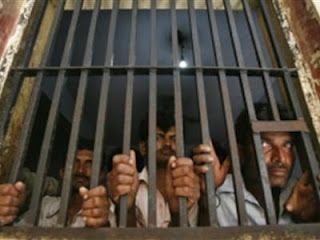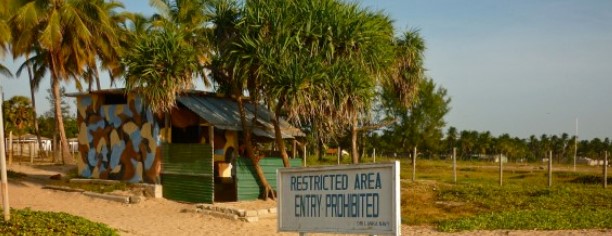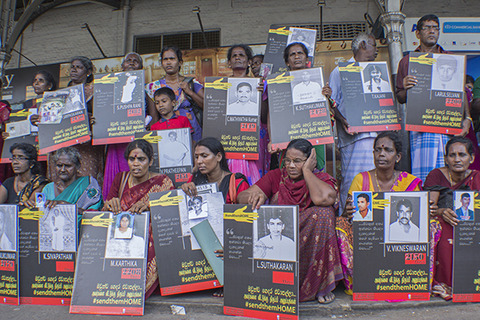Written by: Priyanth Nallaratnam
Since the the 40s, the Sinhala regime has used various tools to eliminate the Tamils in the North and the East. One of the nefarious tools used by the Sri Lankan government today are the clandestine camps which are used as torture facilities. Little is known about these hidden camps, but the facts known about their existence are gruesome and terrifying.
Whether it’s the Rajapaksa regime or the US sponsored Sirisena regime, clandestine camps continue to exist as another tool of the genocidal regime. These camps are well hidden from normal eyes and information from various sources indicates that horrible forms of torture are used against the people held captive. Numerous camps have been spotted across the North and East and it has been estimated that each camp holds hundreds of captives. For example, more than 700 people are held captive in a secret camp operated by the former defense minister Gothabaya Rajapaksa in Trincomalee.
What happens inside these camps are left in the dark. However, a person who escaped the infamous torture facility: the fourth floor, has revealed that torture is used as a tool to break down individuals physically and mentally. These individuals are forced to serve the Sri Lankan government and eliminated if they do not serve their purpose. The former detainee explained that there are only three options available for someone captured to escape: a direct order from the former president, Mahinda Rajapaksa; a visit from EPDP leader, Douglas, who promised life to the broken down recruits if they were willing to work as spies among the Tamil population; or through NGOs that exist to free those that are detained and tortured. Unfortunately the latter only applies to a few of the highly lucky ones (such as our source). Most detainees are eliminated while the remaining number serve as spies among the Tamil population or specific areas of interest to the Sinhala regime.
To this date, protests are conducted demanding the whereabouts of the missing individuals. Outraged families hold pictures of their missing, claiming that they are located in these secret camps. The secret camps are not fourth floor, therefore their secrecy gives them the power to exploit the captives in unimaginable ways. Many of the family members are forced to apply for death certificates to close the case, marking the reason to death as “unknown”. In order to reduce the heat the former president, Mahinda Rajapaksa, launched a commission where more than 15,000 complaints of the disappeared were recorded.
Many of those that went missing were usually arrested by people in military uniforms. Witnesses of these events are coerced with serious threats to remain silent. Because of this coercion, the cases of the missing are often weak. Very few are brave enough to speak out and that is only under the condition that their names are not to be disclosed. Mayuran, who disappeared in 2009, was discovered in a hospital for urinary treatment where several of his relatives reported seeing him. However, when his mother went to see him the hospital administration informed her that no such patient was ever admitted. It was later revealed that the hospital administration was threatened.
There is clear provision in the Sri Lankan constitution that makes arbitrary detention illegal, yet the government uses these tactics under the Prevention of Terrorism act (PTA) to arrest individuals as a threat to state sovereignty. Under the PTA, the accused are held for 18 months in detention. After the 18 months, the defense minister has the power to determine the fate of the detained. Many are reported to be transferred from one camp to another and denied a fair trial.
Even diaspora Tamil activists are not safe, as in the case of Ravindran (real name classified to protect the privacy of the family). Ravindran was detained in the Bandaranaike International Airport under the PTA as having ties with the LTTE. He was transferred multiple times from one facility to another and his time under detention was well above 18 months. He was denied a fair trial, tortured, fell seriously ill due to mistreatment, put under solitary confinement, and went through a hernia operation. Even when the missing were identified (such as Ravindran), their location constantly changed and any documents regarding their case was produced in Sinhalese, a language which could not be understood by Tamils.
These camps are one of the tools that act as a catalyst to speed up the genocidal process of the Sri Lankan state. Despite the constitutional provisions, the NGO’s that continue to fight for the release of those that are detained, and the numerous leaks about the high levels of torture; these camps continue to exist and will continue to exist unless there is an international investigation launched against the state.
The people that continue to be detained in the camps suffer horrendously and the families of the missing continue to suffer not knowing the fate of their missing family members. These camps have been allowed to exist for far too long before the eyes of the international community. The release of those that are detained are not in the hands of the government, but in the collective power of the people in the North and East, the Tamil diaspora, along with world governments and NGO’s mounting pressure on the state to put an end to the ongoing genocide. Until there’s a reliable and impartial international mechanism put in place, individuals will continue to disappear and join the ranks of the hundreds and thousands that are held captive in these camps and tortured under horrific conditions.
Disclaimer: All views and opinions expressed in this article are those of the author and do not necessarily reflect www.tamilyouth.ca’s views and opinions.
Author
 Priyanth Nallaratnam is an Eelam Tamizh youth currently studying Public administration and Governance in the pursuit of finishing law school and attaining a J.D.
Priyanth Nallaratnam is an Eelam Tamizh youth currently studying Public administration and Governance in the pursuit of finishing law school and attaining a J.D.




